I know what some of you must be thinking after my reindeer tartare post: “He’s completely lost touch with reality! He expects us to take a plane to Scandinavia just to buy salami. He thinks Sweden is in Eastern Europe, that every Russian keeps glycerin flakes in their pantry (next to a dozen jars of marinated chanterelles, no doubt), and that he can just add potatoes to any recipe and call it Russian. He’s already claimed that Alsace is where Eastern Europe begins; who knows what he’ll come up with next!”
To help correct this misperception, here’s a recipe to try with the reindeer tartare that will firmly anchor it into northern-Russian cuisine, and not just because there are potatoes. This is a dish that comes from regions so remote you’ve never heard of it (the dish), or them (the regions): the shanga!
A shanga is a kind of bread roll made from an enriched dough and finished with a “filling” spread on top, such as potato purée or tvorog. It originates in the Komi Republic, west of the Ural mountains in northern Russia — in fact, the shanga was chosen to represent the Komi Republic on the Tasty Map of Russia. And there are indeed reindeer herds there, which proves there’s method to my madness. The dish is best explained in Russia’s Cooking: Tradition and Modernity:
The Komi people are real masters at baking. The word shanga is from the Komi language. Dal’s dictionary defines it as “sour bread, rye, barley, and wheat bathed in butter and sour cream, a vatrushka with porridge with crumpled potatoes or cottage cheese, covered in sour cream on top”. But a shanga is not a vatrushka. It’s not filled to the brim with the filling, just basted with this or that kind of baste. The dough can be sweet or not, and the baste can be made from many things, like potatoes, cheese, wild cherry, peas, cereals, or sour cream.
After reading that passage, it should come as no surprise that shanga recipes vary wildly. Many of them are definitely of the vatrushka variety, adding a lot of filling (like here). In some cases, the shanga even becomes a pie or a tartlet (here, or here). Potato is the most frequent filling, but I saw examples with tvorog (here), mushrooms (here), carrot (here), rice, or chicken liver (both here). Sometimes the dough is made without yeast (here). It’s even become a source of inspiration for the many people who can’t necessarily cook but love showing off with their food pictures (here).
I decided to create two shanga recipes, both with potato, since it’s such a popular filling (and remember, Russia = potato on this blog, right?), and a sour cream egg wash, since that seems quite common as well. The first recipe uses a traditional enriched dough. It’s vaguely inspired by a recipe in Russia’s Cooking: Tradition and Modernity, but I’ve made many changes. Although I make a slight indentation in which to put the filling, this shanga remains basically a bread with a little something on top. The result is tasty and airy, and best when eaten only minutes after coming out of the oven. Even so, to me, it’s not to die for.
For the second version, I use a laminated yeast dough, similar to a croissant dough (some of my dough instructions are directly adapted from this croissant recipe). I figure that if the Komi people are such masters at baking, spending a few hours working on a laminated dough should be a pleasure. And the results? Highly addictive and well worth the effort. You might even want to try them without that reindeer tartare…
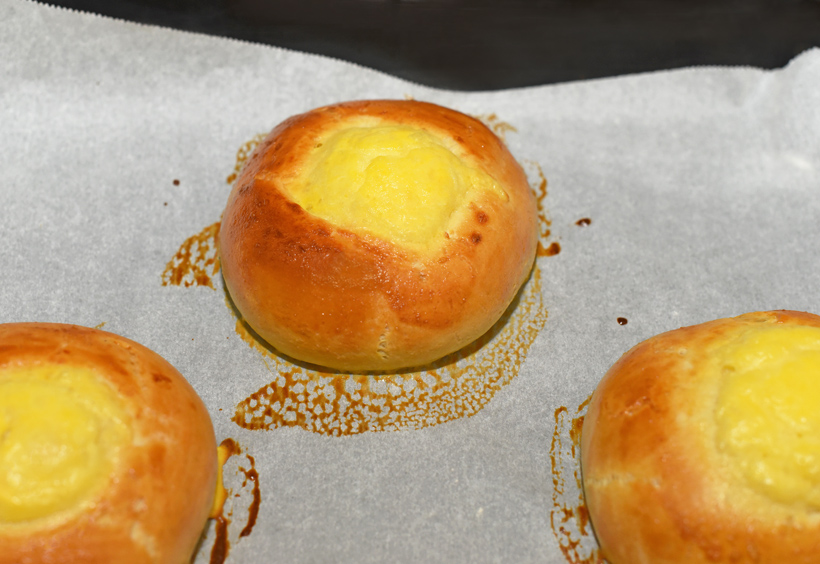
Potato filling
Yields 6 shangas
120 g peeled Yukon Gold potato
salt
30 g butter
10 g heavy cream
15 g egg, beaten
- Place the potatoes in a saucepan, fill the pan with water, and add salt. Cover and simmer over medium heat until cooked.
- Drain the potatoes, rice, and transfer to a bowl. Add the butter and cream, and combine with a spatula. Let cool for a couple minutes.
- Rectify the seasoning, add the egg, and combine thoroughly. Then let cool and refrigerate.
Traditional shanga dough
Yields 6 shangas
6 g active dry yeast
8 g sugar
70 g milk, lukewarm
60 g water
290 g bread flour
6 g salt
60 g butter, melted
40 g egg yolks
- In a small bowl, combine the yeast, sugar, and milk. Let rest for 5 minutes.
- Transfer to the bowl of an electric mixer fit with the paddle attachment, and add the water. Add half of the flour, then mix on medium speed for 1 minute.
- Add the rest of the flour, salt, butter, and egg yolks. Mix for another minute on medium speed, then switch to the dough hook attachment, and knead for 4 minutes, still on medium. Cover with plastic wrap, and let rise for 1 to 1 1/2 hours, until doubled in volume.
- Punch down the dough, and let rise again for 45 minutes to an hour.
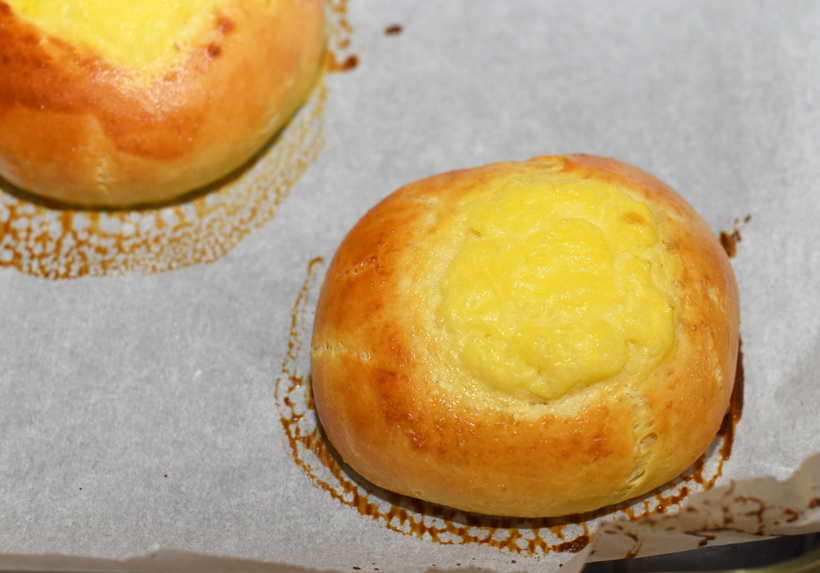
Traditional potato shangas
Yields 6 shangas
flour (for dusting)
traditional shanga dough
potato filling
35 g sour cream
35 g egg yolk
25 g butter, melted
- On a floured surface, divide the dough into 6 parts of about 85 g each. Using your palm, flatten each part into a disc of 8 cm diameter. Use your thumb to make a depression in the center, a bit like you would do for a bialy, but not as deep. Fill the depression with potato filling, but not too much — remember, a shanga is essentially a bread with something on top. I use about one heaped teaspoon of filling per shanga; there might be some leftover filling.
- Transfer the shangas to one or more large baking pans lined with parchment paper, cover with plastic wrap, and proof in a 38 C / 100 F environment for about 30 minutes. You can also let them rest on the stovetop while the oven is heating.
- Place a dish full of hot water on the bottom rack of your oven, and heat to 200 C / 400 F.
- Combine the sour cream and egg yolk in a small bowl, then brush the top of the potato shangas generously with the mixture.
- Bake in the oven for about 20 minutes, until golden brown.
- Transfer the shangas to a cooling rack, and brush generously with melted butter. Eat as soon as possible.
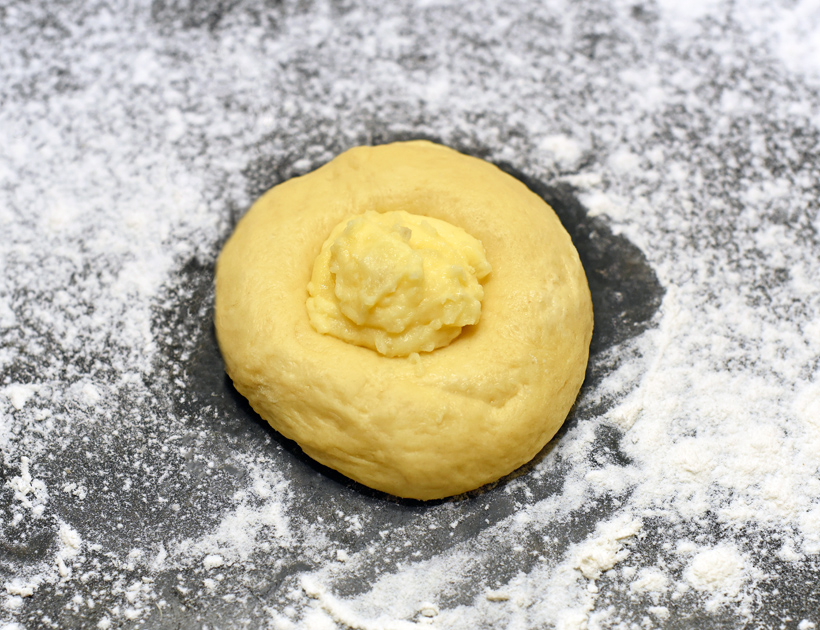
Traditional potato shangas before proofing
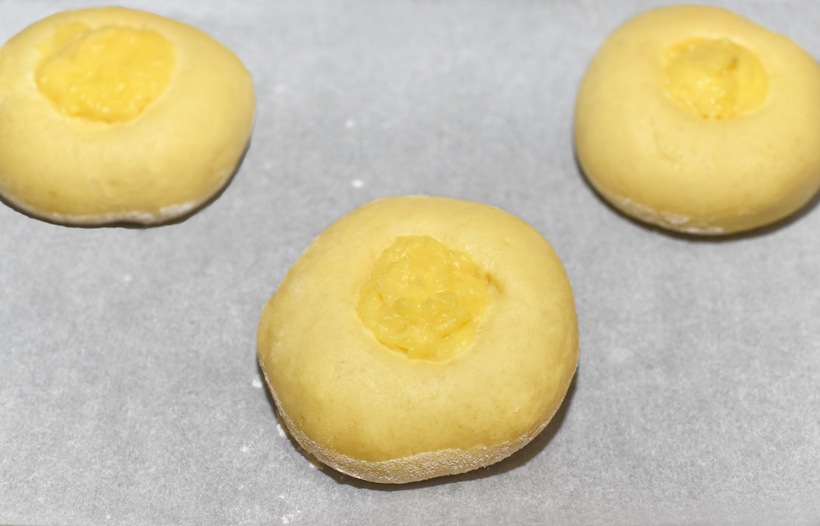
Traditional potato shangas after proofing
Laminated shanga dough
Yields 6 shangas
120 g butter
flour (for dusting)
traditional shanga dough
- Shape the butter into a 7.5 cm x 15 cm rectangle. To do this, arrange thick slices of butter to the approximate dimensions on a sheet of plastic wrap, cover with more plastic wrap, and roll gently with a rolling pin to help seal the butter pieces together and adjust the rectangle to the right dimensions.
- On a floured surface, roll the dough to 20 cm x 25 cm. Arrange the dough with a short side facing you. Place the butter (without the plastic wrap, obviously) in the center of the dough so that the long sides of the butter are parallel to the short sides of the dough. Fold like a letter paper, bottom third of the dough over the butter, then top third down over the bottom dough. Brush off any excess flour.
- Roll the dough back into a 20 cm x 24 cm rectangle (yes, it’s shorter by 1 cm). Arrange the dough with a short side facing you. Fold in thirds again, as above. You may need to stretch the corners to square it off. Cover with plastic wrap, and refrigerate for at least 30 minutes.
- Repeat the previous step three more times. If any butter oozes out while rolling, sprinkle with a little bit of flour to prevent sticking. Cover with plastic wrap, and refrigerate for at least 8 hours.
Laminated potato shangas
Yields 6 shangas
flour (for dusting)
laminated shanga dough
potato filling
35 g sour cream
35 g egg yolk
- On a lightly floured surface, roll the laminated dough to a 16 cm x 24 cm rectangle. Cut six discs using an 8 cm diameter ring mold. Use your thumb to make a depression in the center, and fill the depression with a little bit of potato filling (just like for the traditional shangas above). You might have some leftover filling.
- Transfer the shangas to one or more large baking pans lined with parchment paper, cover with plastic wrap, and proof in a 38 C / 100 F environment (or on your warming stovetop) for about 30 minutes.
- Place a dish full of hot water on the bottom rack of your oven, and heat to 200 C / 400 F.
- Combine the sour cream and egg yolk in a small bowl, then brush the top of the potato shangas generously with the mixture.
- Bake in the oven for about 25 minutes, until golden brown.
- Transfer the shangas to a cooling rack, and eat as soon as possible.
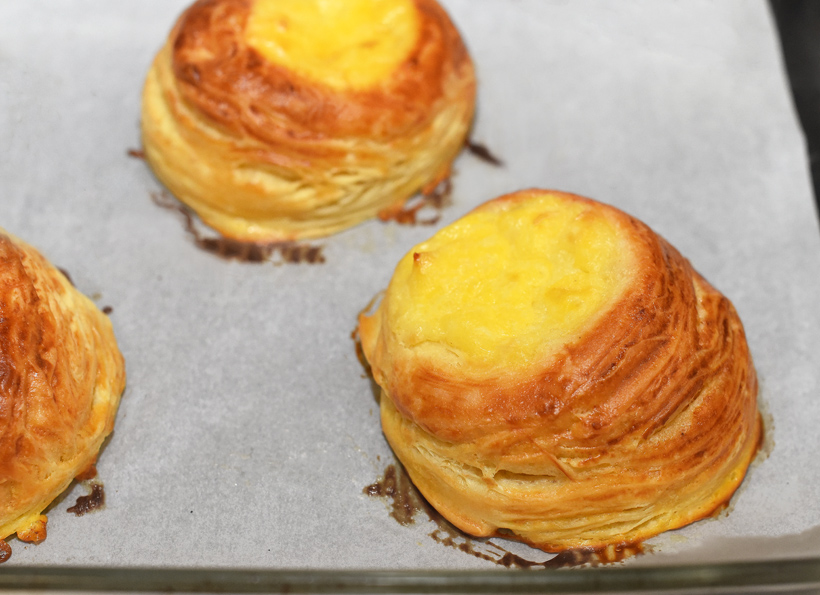


3 comments
ochen interesno!!!
My mother used to bake shangi in my childhood and spread a little salted sour cream on top with some crumbs, maybe grated flour with butter. She was born in Penza (Mordovia), I thought shangi is from Siberia.
She baked a lot pies and shangis and korzhiks
Shangi are baked in Perm. It is a common dish there